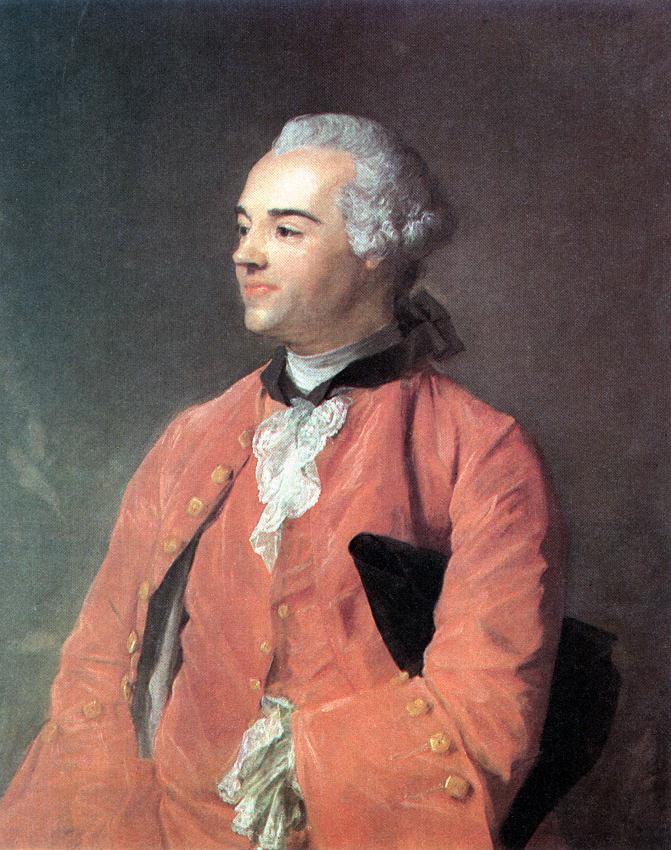JACQUES CAZOTTE
Jacques Cazotte (1719-1792) was a French author and colonial administrator. Cazotte was born in Dijon where he was educated at the Jesuit college. After moving to Paris he started writing. In 1741 and 1742 he published the cycles La patte du chat and Les mille et une fadaises. In 1747 he was sent to Martinique as an administrator. After his return he dedicated himself fully to writing, and in 1772 he published his masterpiece, the short novel Le diable amoureux. Later in his life the staunchly Catholic Cazotte became interested in the occult order of the Martinists, although it is not certain that he joined it. He was openly against the French Revolution and he was decapitated on the guillotine in 1792.
The fragments:
The novel Le diable amoureux (1772) is often considered the first example of French fantastic literature, because it seems to mingle reality and hallucination leaving the reader in doubt as to the veracity of the story. Cazotte's novel is about a nobleman agreeing to a pact with the devil and entering a kind of diffuse zone in which he has visions of a mysterious creature who dominates his life. In the end it is suggested that his sensations were a dream. A link with the Thousand and one nights has been suggested not only because of the intervention of supernatural, which is common in the Nights, but more specifically because the scene in which Alvaro encounters the devil seems to be modelled on a similar scene in the story of ‘Aladdin and the magic lamp’. This parallel shows the influence of the Thousand and one nights on the development of fantastic and Gothic literature from the 18th century onwards.
Cazotte’s interest in the Thousand and one nights is confirmed by his collection Continuation des Mille et une nuits (1788). This book contains Oriental tales which were partly (reworked) translations and partly original material. The basis for the text is a manuscript of the Thousand and one nights compiled by the Arabic scholar Dom Chavis, who resided in Paris. Cazotte asked Dom Chavis to translate his tales and edited the translation for his Continuation. Some of the resulting tales follow the original quite closely; others are adapted or supplemented by Cazotte. The cycle of the sorcerer Maugraby was originally written by Cazotte. The Continuation is thus a complex, hybrid work, which reflects the way in which the material of the Thousand and one nights was received by and incorporated into the European literary domain, through translation, bricolage and imitation. Of course the hybrid character of the work makes it the more interesting from the perspective of the influence of Galland’s Mille et une nuit, the emergence of fantastic literature, and the significance of orientalism in the development of European genres, and, in the case of Cazotte, views of religion and the supernatural. The manuscript of Dom Chavis was later translated into French by Caussin de Perceval.
The fragments are from Le diable amoureux, the first chapters with the encounter with the demon; the story of ‘Simoustapha’, from Suite des Mille et ne nuits, which is a more or less faithful translation in the beginning but is supplemented by Cazotte, thus showing the transition from translation to original work and the difference in style between the two components; and the story of ‘Maugraby’ from the Maugraby-cycle in the Suite des Mille et une nuits originally written by Cazotte, inspired by the story of ‘Aladdin’ and others.

Sources/references:
Ulrich Marzolph/ Richard van Leeuwen (eds.), The Arabian nights encyclopedia, 2 vols., ABC-Clio, Santa Barbara etc. 2004.
Edward Pease Shaw, Jacques Cazotte (1719-1792), Harvard University Press, Cambridge 1942.
Francoise Gevrey/ Jean-Louis Haquette (eds.), Visages de Cazotte, ÉPURE, Reims 2010.
Claudine Hunting, ‘Les mille et une sources du Diable amoureux de Cazotte,’ Studies in Voltaire and the eighteenth century, vol. 230 (1985), pp. 247-271.
Antoine Faivre, L’Ésoterisme au XVIIIe siècle, Seghers, Paris 1973.
Adolphe Franck, La philosophie mystique en France à la fin du XVIIIe siècle: Saint-Martin et son maître Martinez Pasqualis, Germer Baillière, Paris 1866. (Primary Source Edition)
Richard van Leeuwen, ‘The Thousand and one nights and the formation of genre: the case of Jacques Cazotte,’ in: Christian Szyska/ Friederile Pannewick (eds.), Crossings and passages in genre and culture, Reichert Verlag, Wiesbaden 2003, pp. 53-63.
Richard van Leeuwen, ‘Religion and oriental tales in the 18th century: the emergence of the fantastic genre,’ Francofonia, vol. XXXV, no. 69 (Autumn 2015), Variations francaises sur les Mille et une nuits: quelles versions pour quells effets?, Olscki Editore, Firenze 2015, pp. 35-56.
J.B. Baronian, Panorama de la literature fantastique de langue francaise, Stock, Paris 1978.
Dufrenoy, Marie-Louise, L’Orient romanesque en France (1704-1789), 3 vols., Montreal: Beauchemin (vols. 1-2), Amsterdam: Rodopi (vol. 3), 1946-1975.
Martino, Pierre, L’Orient dans la littérature Francaise au XVIIe au XVIIIe siècle, Paris: Librairie Hachette, 1906.
Weblinks:
http://www.gutenberg.org/etext/23289 (Project Gutenberg)
http://catalogue.bnf.fr/ark:/12148/cb11895697m (Bibliothèque Nationale de France)